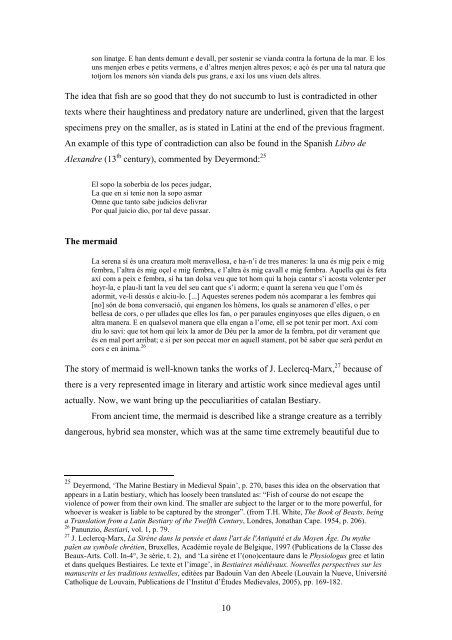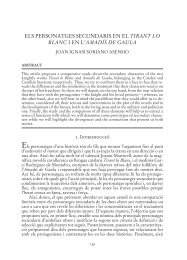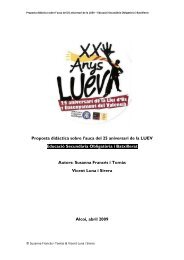Aquatic animals in the Catalan Bestiari - Institut Interuniversitari de ...
Aquatic animals in the Catalan Bestiari - Institut Interuniversitari de ...
Aquatic animals in the Catalan Bestiari - Institut Interuniversitari de ...
You also want an ePaper? Increase the reach of your titles
YUMPU automatically turns print PDFs into web optimized ePapers that Google loves.
son l<strong>in</strong>atge. E han <strong>de</strong>nts <strong>de</strong>munt e <strong>de</strong>vall, per sostenir se vianda contra la fortuna <strong>de</strong> la mar. E los<br />
uns menjen erbes e petits vermens, e d’altres menjen altres pexos; e açò és per una tal natura que<br />
totjorn los menors són vianda <strong>de</strong>ls pus grans, e axí los uns viuen <strong>de</strong>ls altres.<br />
The i<strong>de</strong>a that fish are so good that <strong>the</strong>y do not succumb to lust is contradicted <strong>in</strong> o<strong>the</strong>r<br />
texts where <strong>the</strong>ir haught<strong>in</strong>ess and predatory nature are un<strong>de</strong>rl<strong>in</strong>ed, given that <strong>the</strong> largest<br />
specimens prey on <strong>the</strong> smaller, as is stated <strong>in</strong> Lat<strong>in</strong>i at <strong>the</strong> end of <strong>the</strong> previous fragment.<br />
An example of this type of contradiction can also be found <strong>in</strong> <strong>the</strong> Spanish Libro <strong>de</strong><br />
Alexandre (13 th century), commented by Deyermond: 25<br />
El sopo la soberbia <strong>de</strong> los peces judgar,<br />
La que en sí tenie non la sopo asmar<br />
Omne que tanto sabe judicios <strong>de</strong>livrar<br />
Por qual juicio dio, por tal <strong>de</strong>ve passar.<br />
The mermaid<br />
La serena sí és una creatura molt meravellosa, e ha-n’i <strong>de</strong> tres maneres: la una és mig peix e mig<br />
fembra, l’altra és mig oçel e mig fembra, e l’altra és mig cavall e mig fembra. Aquella qui és feta<br />
axí com a peix e fembra, sí ha tan dolsa veu que tot hom qui la hoja cantar s’i acosta volenter per<br />
hoyr-la, e plau-li tant la veu <strong>de</strong>l seu cant que s’i adorm; e quant la serena veu que l’om és<br />
adormit, ve-li <strong>de</strong>ssús e alciu-lo. [...] Aquestes serenes po<strong>de</strong>m nós acomparar a les fembres qui<br />
[no] són <strong>de</strong> bona conversació, qui enganen los hòmens, los quals se anamoren d’elles, o per<br />
bellesa <strong>de</strong> cors, o per ulla<strong>de</strong>s que elles los fan, o per paraules eng<strong>in</strong>yoses que elles diguen, o en<br />
altra manera. E en qualsevol manera que ella engan a l’ome, ell se pot tenir per mort. Axí com<br />
diu lo savi: que tot hom qui leix la amor <strong>de</strong> Déu per la amor <strong>de</strong> la fembra, pot dir verament que<br />
és en mal port arribat; e si per son peccat mor en aquell stament, pot bé saber que serà perdut en<br />
cors e en ànima. 26<br />
The story of mermaid is well-known tanks <strong>the</strong> works of J. Leclercq-Marx, 27 because of<br />
<strong>the</strong>re is a very represented image <strong>in</strong> literary and artistic work s<strong>in</strong>ce medieval ages until<br />
actually. Now, we want br<strong>in</strong>g up <strong>the</strong> pecculiarities of catalan Bestiary.<br />
From ancient time, <strong>the</strong> mermaid is <strong>de</strong>scribed like a strange creature as a terribly<br />
dangerous, hybrid sea monster, which was at <strong>the</strong> same time extremely beautiful due to<br />
25 Deyermond, ‘The Mar<strong>in</strong>e Bestiary <strong>in</strong> Medieval Spa<strong>in</strong>’, p. 270, bases this i<strong>de</strong>a on <strong>the</strong> observation that<br />
appears <strong>in</strong> a Lat<strong>in</strong> bestiary, which has loosely been translated as: “Fish of course do not escape <strong>the</strong><br />
violence of power from <strong>the</strong>ir own k<strong>in</strong>d. The smaller are subject to <strong>the</strong> larger or to <strong>the</strong> more powerful, for<br />
whoever is weaker is liable to be captured by <strong>the</strong> stronger”. (from T.H. White, The Book of Beasts, be<strong>in</strong>g<br />
a Translation from a Lat<strong>in</strong> Bestiary of <strong>the</strong> Twelfth Century, Londres, Jonathan Cape. 1954, p. 206).<br />
26 Panunzio, <strong>Bestiari</strong>, vol. 1, p. 79.<br />
27 J. Leclercq-Marx, La Sirène dans la pensée et dans l'art <strong>de</strong> l'Antiquité et du Moyen Âge. Du my<strong>the</strong><br />
païen au symbole chrétien, Bruxelles, Académie royale <strong>de</strong> Belgique, 1997 (Publications <strong>de</strong> la Classe <strong>de</strong>s<br />
Beaux-Arts. Coll. In-4°, 3e série, t. 2), and ‘La sirène et l’(ono)centaure dans le Physiologus grec et lat<strong>in</strong><br />
et dans quelques Bestiaires. Le texte et l’image’, <strong>in</strong> Bestiaires médiévaux. Nouvelles perspectives sur les<br />
manuscrits et les traditions textuelles, editées par Badou<strong>in</strong> Van <strong>de</strong>n Abeele (Louva<strong>in</strong> la Nueve, Université<br />
Catholique <strong>de</strong> Louva<strong>in</strong>, Publications <strong>de</strong> l’<strong>Institut</strong> d’Étu<strong>de</strong>s Medievales, 2005), pp. 169-182.<br />
10




